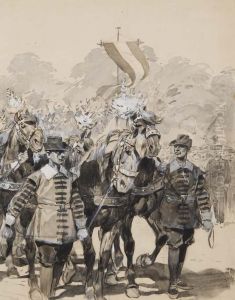Otto Gerlach Paintings
Otto Gerlach was a German expressionist painter, born in 1886. His work is less known compared to the giants of Expressionism like Ernst Ludwig Kirchner or Emil Nolde, but his contributions to the movement provide a unique perspective on the emotional and psychological exploration that characterized early 20th-century German art. Gerlach's early life and education were steeped in the rich cultural environment of Germany at the turn of the century, a period marked by rapid modernization and the flourishing of the arts and literature.
Gerlach's artistic journey began at the Dresden Academy of Fine Arts, where he was exposed to the burgeoning Expressionist movement, which sought to convey emotional experience rather than physical reality. This movement, along with influences from Impressionism and Post-Impressionism, which emphasized the importance of color and brushwork, deeply impacted Gerlach's style. His works, characterized by bold colors, dramatic forms, and a sense of emotional urgency, sought to capture the existential angst and euphoria of the modern human experience.
Throughout his career, Gerlach navigated the tumultuous landscape of early 20th-century Europe, with World War I and the subsequent political upheavals leaving an indelible mark on his work. His paintings from this period reflect a world in turmoil, with distorted forms and agitated brushstrokes that convey a sense of dislocation and despair.
Unfortunately, Otto Gerlach's career was cut short by the rise of the Nazi regime in Germany. His art, like that of many of his contemporaries, was deemed 'degenerate' by the Nazis, leading to a period of obscurity and hardship. Gerlach died in 1944, his work largely unrecognized at the time. However, posthumously, his contributions to Expressionism have been re-evaluated, and he is now regarded as an important, if underappreciated, figure in the movement. His paintings, with their intense emotional resonance and stark portrayal of the human condition, continue to captivate and challenge audiences, offering a window into the soul of a tumultuous era.
